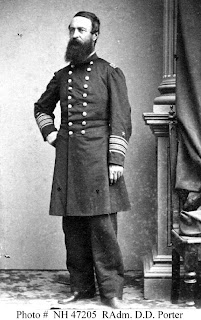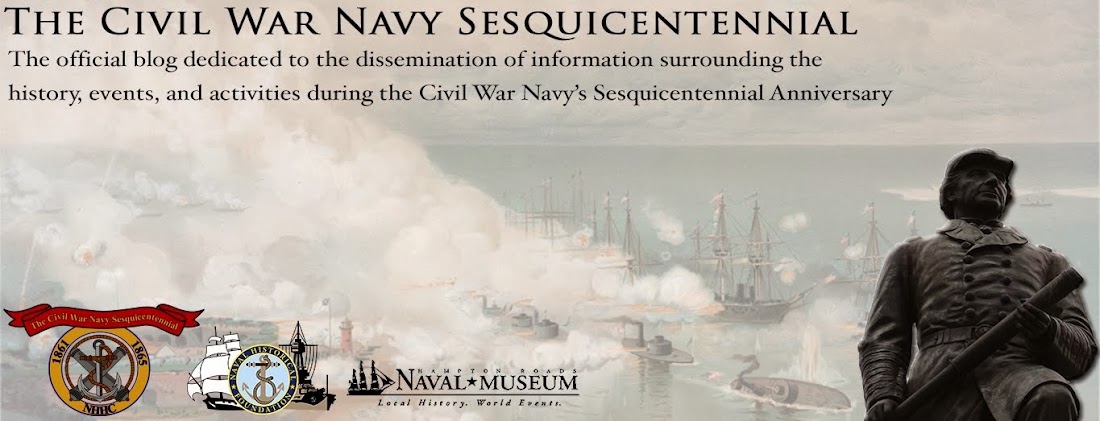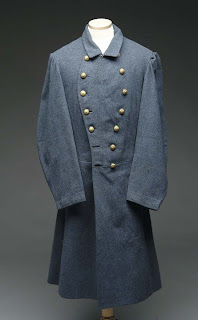 Rear Admiral Raphael Semmes, famed Captain of the CSS Alabama and Sumter, won this past week's quarterfinal poll against John M. Brooke. Semmes received a decisive 15 votes to Brooke's 2. The final quarterfinal poll is posted, squaring Matthew F. Maury against Thomas Lockwood. After the final quarterfinal poll is completed, we will begin the exciting semifinal polls with the remaining four winners from previous polls.
Rear Admiral Raphael Semmes, famed Captain of the CSS Alabama and Sumter, won this past week's quarterfinal poll against John M. Brooke. Semmes received a decisive 15 votes to Brooke's 2. The final quarterfinal poll is posted, squaring Matthew F. Maury against Thomas Lockwood. After the final quarterfinal poll is completed, we will begin the exciting semifinal polls with the remaining four winners from previous polls.
Monday, January 31, 2011
Raphael Semmes Wins Quarterfinal Poll #3; Final Quarterfinal Poll Posted
 Rear Admiral Raphael Semmes, famed Captain of the CSS Alabama and Sumter, won this past week's quarterfinal poll against John M. Brooke. Semmes received a decisive 15 votes to Brooke's 2. The final quarterfinal poll is posted, squaring Matthew F. Maury against Thomas Lockwood. After the final quarterfinal poll is completed, we will begin the exciting semifinal polls with the remaining four winners from previous polls.
Rear Admiral Raphael Semmes, famed Captain of the CSS Alabama and Sumter, won this past week's quarterfinal poll against John M. Brooke. Semmes received a decisive 15 votes to Brooke's 2. The final quarterfinal poll is posted, squaring Matthew F. Maury against Thomas Lockwood. After the final quarterfinal poll is completed, we will begin the exciting semifinal polls with the remaining four winners from previous polls.
Monday, January 24, 2011
Civil War Navy in the News
 According to associated content on Yahoo News, artifacts from the USS Westfield, a Federal gunboat converted from a civilian ferryboat that ran aground and sank near Galveston Island, has surfaced important artifacts in recent days. Recovery experts for the USS Westfield under the direction of the Army Corps of Engineers and the U.S. Navy began in November 2009. Recently, however, new items have surfaced. According to the Yahoo newswire report:
According to associated content on Yahoo News, artifacts from the USS Westfield, a Federal gunboat converted from a civilian ferryboat that ran aground and sank near Galveston Island, has surfaced important artifacts in recent days. Recovery experts for the USS Westfield under the direction of the Army Corps of Engineers and the U.S. Navy began in November 2009. Recently, however, new items have surfaced. According to the Yahoo newswire report:"On Wednesday, January 19, 2011 Galveston County, The Daily News, announced that four cannonballs were recovered from near the resting place of the large cannon. Explosive experts from the Navy and Marine Corps were on hand for any possible necessary disarming of the devices. Other artifacts from the site have been recovered but skeletal remains of the captain and crew members of the USS Westfield are not expected to be found intact after so long a time."
The latest blog post from the Civil War Picket has some great information concerning Columbus, GA and its involvement (i.e. a "military industrial complex") in the Civil War. According to Phil Gast, author of the blog, Columbus ranked only second to Richmond in producing supplies and weapons for the Confederacy. Within their capacity, the city along the Chattahoochee River made gunboats for the Confederate Navy during the war. Columbus, GA is also the current home of the National Civil War Naval Museum.
There is also a great quote included on the Civil War Interactive Newswire. The 24 January quote is from Admiral David Dixon Porter, writing from the Yazoo River in 1863. Writing to Secretary of the Navy Gideon Welles of his success in capturing 11 Confederate steamers on the way to Vicksburg, he stated that:
"I am guarding the Yazoo River. The front…is heavily fortified. Unless we can get troops in the rear of the city I see no chance of taking it…though we cut off all their supplies.”
If you would like more information on David Dixon Porter, you can read his Naval History of the Civil War HERE for free, courtesy of Google Books.
Sunday, January 23, 2011
User Curated Online Exhibit: CWN 150 Images
Instead of simply posting the images here from the Facebook page, we thought we might try something a bit different. Although many CWN 150 staff have information on these photographs, we thought it might be interested if YOU, the reader, gave us your information and interpretation on these images. Only the information provided by Mr. Edwards will be included for each photograph. It will be up to you all to add any additional information you may have. Think of it as an online exhibit where the audience will do the interpretation. Post any information you have in the comments section of this post (and indicate the image #) Have fun with it!
Image 001

Image 002

Image 003
William Cushing Wins Quarterfinal Poll #2; Quarterfinal Poll #3 Posted
David Dixon Porter with members of his staff, on board his flagship USS Malvern in Hampton Roads, Virginia, December 1864. William Cushing is standing to the far left of the picture.
Lt. Commander William Cushing, USN, who Secretary of the Navy Gideon Welles once called "the hero of the War," won this past week's second quarterfinal poll against Andrew H. Foote. Foote received six votes compared to Cushing's ten. During the Civil War, he distinguished himself during engagements against the CSS Albemarle as well as the landing at Fort Fisher, NC, in January 1865. A brief bio is reproduced once again HERE, courtesy of the Naval History and Heritage Command.
 LCdr. Cushing's Carte de Visite, circa 1864-1865
LCdr. Cushing's Carte de Visite, circa 1864-1865
This completes the quarterfinal polls for Union officers. In three weeks, readers will decide who will represent the best Union naval leader: William Cushing or David Dixon Porter? Please stay tuned for that. The photo shown above is a perfect example of the contest to come: the seasoned veteran or the maverick and brave "up and comer?"
In the meantime, the newest (Quarterfinal Poll #3) will be available to vote on this blog. This will introduce the first two of the four remaining Confederate naval officers: Raphael Semmes and John M. Brooke.
Saturday, January 15, 2011
David Dixon Porter Wins Quarterfinal Poll #1; New Poll Posted
 David Dixon Porter decisively won the first Quarterfinal readers poll asking you the question” Who Was the Greatest Officer During the Civil War?” Admiral Porter received the sum total of votes for the week’s voting (12). You can see a brief biography and photo archive of David Dixon Porter HERE, courtesy of the Naval History and Heritage Command.
David Dixon Porter decisively won the first Quarterfinal readers poll asking you the question” Who Was the Greatest Officer During the Civil War?” Admiral Porter received the sum total of votes for the week’s voting (12). You can see a brief biography and photo archive of David Dixon Porter HERE, courtesy of the Naval History and Heritage Command.The second Quarterfinal poll is currently posted on this blog. William Cushing, the "Commando" most famous for his sinking of the CSS Albemarle in 1864 will square off against Andrew Hull Foote, who led a highly distinguished career before he died in 1863.
Friday, January 7, 2011
USS Brooklyn and Fort Sumter

Commissioned in January 1859, the Brooklyn was among the US Navy's newest ships and reflected some of the cutting edge naval technology of the time. Her horizontal action steam engines turned a screw propeller which gave the ship an 11 knot top speed. She carried twenty-two IX-inch Dahlgren smoothbore guns. Such reflected naval ordnance trends towards all big gun batteries capable of firing both shell and solid shot.
In the first days of January, 1861, the Brooklyn lay at Hampton Roads, Virginia. On January 7, Secretary Isaac Toucey sent orders to Captain William S. Walker, commanding the Brooklyn, to sail toward Charleston.
Walker's orders were to proceed to the bar off Charleston harbor and deliver revised instructions to the army officer commanding a detachment of troops on the steamer Star of the West. The Star of the West had left New York several days earlier carrying reinforcements and supplies for Fort Sumter. According to the revised instructions the steamer would proceed to Hampton Roads, where the troops would disembark. If the troops were already unloaded at Fort Sumter, Walker was to return to Virginia. Although authorized to give "aid and succor" if the Star of the West was fired upon, Walker was not to take the Brooklyn past the bar outside Charleston.
Walker did not receive those orders until the morning of January 9. Even though he set sail by 11:45 a.m. that day, events had already overtaken his mission. That same morning, cadets from the Citadel, stationed on Morris Island outside Charleston, fired upon the Star of the West. The aggressive act caused the ship's captain to abandon the effort and turn back for New York.
Walker arrived off Charleston on January 12 to learn of the Star's repulse. He reported navigation lights dampened, passages blocked with obstructions, and batteries along the shorelines. Thus, one of the first missions of the war for the US Navy ended with a failed rendezvous and undelivered message.
Only following four years of war would US Navy warships venture again past the bar into Charleston Harbor.
----------------------
References:
Official Records of the Union and Confederate Navies in the War of the Rebellion; Series I - Volume 4, pages 220-221.
Official Records of the Union and Confederate Armies in the War of the Rebellion; Series 1 - Volume 1, page 134.









